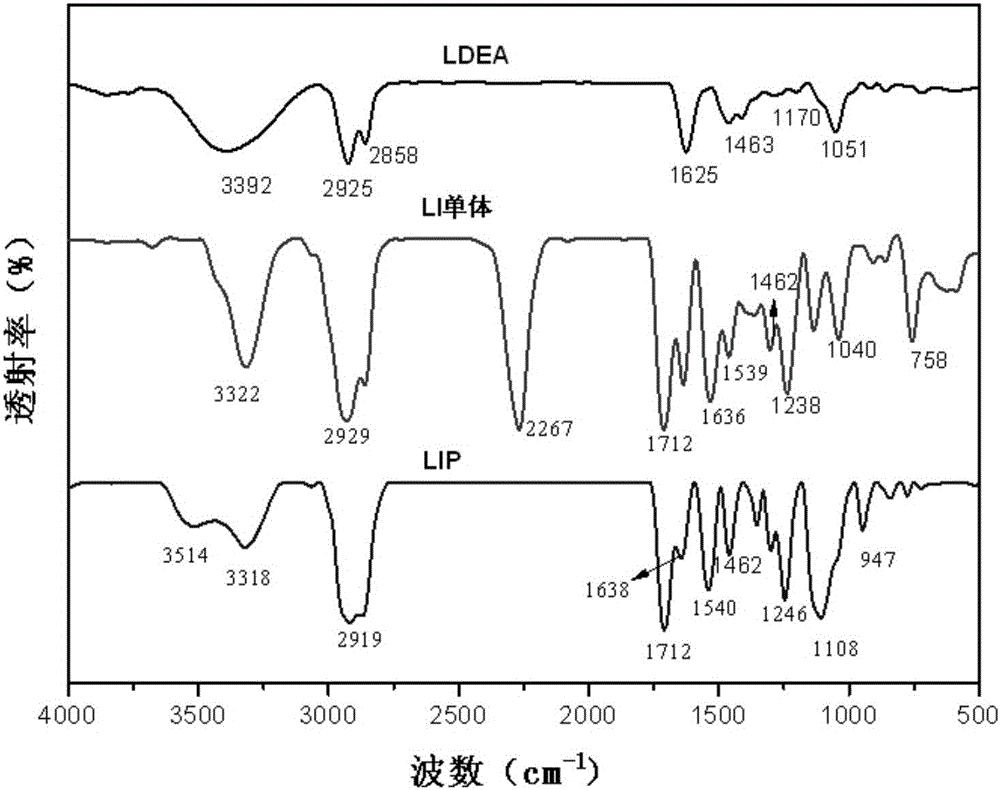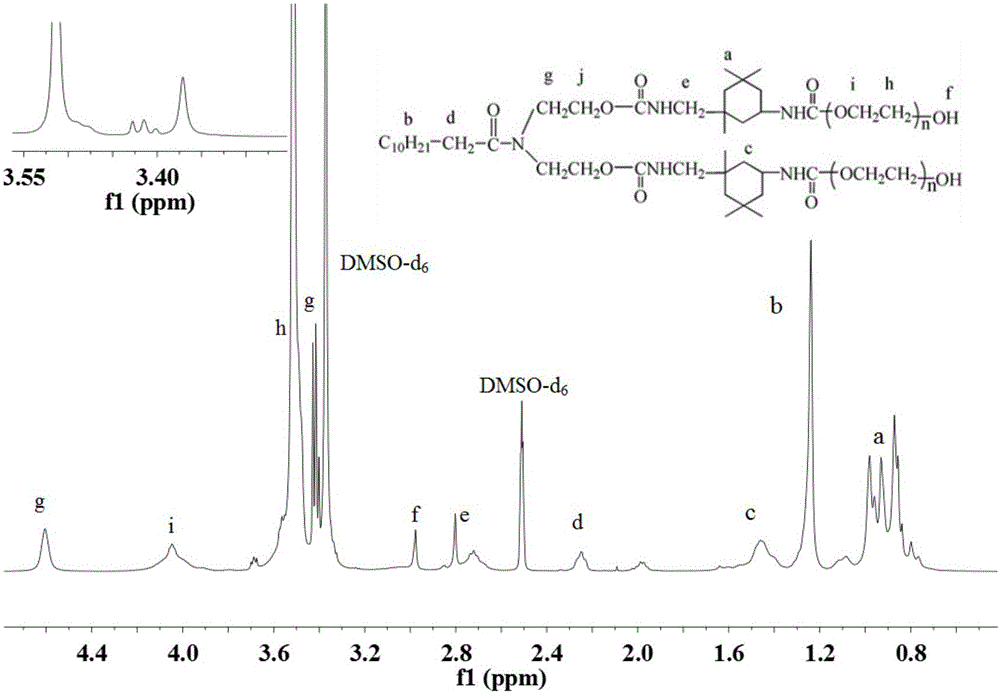LIP type nonionic surfactant, preparation method and applications thereof
A non-ionic surface and active agent technology, applied in the direction of chemical paint/ink remover, coating, etc., to achieve the effect of good appearance, strong capture and emulsification ability, and high whiteness
- Summary
- Abstract
- Description
- Claims
- Application Information
AI Technical Summary
Problems solved by technology
Method used
Image
Examples
Embodiment 1
[0039] 1) First add 2mol of isophorone diisocyanate (IPDI) into the reactor, and heat to 50°C at a stirring speed of 200r / min;
[0040] 2) Then slowly add 1 mol of lauric acid diethanolamide (LDEA) into the reactor at a drop rate of 6d / min at a stirring speed of 400r / min, and add 10mL of chloroform for viscosity reduction, and continue to Stir and keep warm for 60 minutes;
[0041] 3) Add 2mol PEG-400 into the reactor quickly within 5s at a stirring speed of 200r / min, continue to react at a reaction temperature of 60°C for 90min until the end of the reaction, and then cool down to room temperature to obtain a LIP type nonionic Surfactant (n=9 in molecular formula).
[0042] The LIP type nonionic surfactant prepared in Example 1 is used alone as a deinking agent for waste paper deinking, and is denoted as LIP-1.
Embodiment 2
[0044] 1) First add 2mol of isophorone diisocyanate (IPDI) into the reactor, and heat to 55°C at a stirring speed of 250r / min;
[0045] 2) Then slowly add 1 mol of lauric acid diethanolamide (LDEA) into the reactor at a drop rate of 10d / min at a stirring speed of 450r / min, and add 12mL of chloroform for viscosity reduction, and continue to Stir and keep warm for 90min;
[0046] 3) Add 2mol PEG-600 into the reactor quickly within 20s at a stirring speed of 250r / min, continue the reaction at a reaction temperature of 70°C for 120min until the end of the reaction, and then lower it to room temperature to obtain a LIP type nonionic Surfactant.
[0047] The LIP type nonionic surfactant prepared in Example 2 is used alone as a deinking agent for waste paper deinking, and is denoted as LIP-2.
[0048] The molecular structural formula of LIP-2 is shown in formula (1),
[0049]
[0050] where n=13.
[0051] IR and 1 H-NMR analysis
[0052] 1. The infrared spectrum of LIP-2
...
Embodiment 3
[0057] 1) First add 2mol of isophorone diisocyanate (IPDI) into the reactor, and heat to 55°C at a stirring speed of 300r / min;
[0058] 2) Then at a stirring speed of 500r / min, slowly add 1 mol of lauric acid diethanolamide into the reactor at a dropping speed of 6d / min, and add 15mL of chloroform to reduce the viscosity, continue to stir and keep warm after the dropping Reaction 120min;
[0059] 3) Add 2mol PEG-600 into the reactor quickly within 5s at a stirring speed of 300r / min, continue the reaction at a reaction temperature of 90°C for 150min until the end of the reaction, and then lower it to room temperature to obtain a LIP-type nonionic Surfactant.
[0060] The LIP type nonionic surfactant prepared in Example 3 is used alone as a deinking agent for waste paper deinking, and is denoted as LIP-3.
PUM
 Login to View More
Login to View More Abstract
Description
Claims
Application Information
 Login to View More
Login to View More - R&D
- Intellectual Property
- Life Sciences
- Materials
- Tech Scout
- Unparalleled Data Quality
- Higher Quality Content
- 60% Fewer Hallucinations
Browse by: Latest US Patents, China's latest patents, Technical Efficacy Thesaurus, Application Domain, Technology Topic, Popular Technical Reports.
© 2025 PatSnap. All rights reserved.Legal|Privacy policy|Modern Slavery Act Transparency Statement|Sitemap|About US| Contact US: help@patsnap.com



